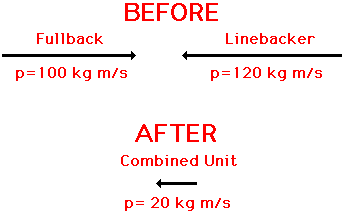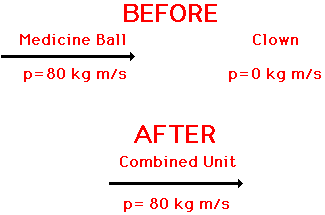Sanveg Sanrakhshan Ka Sidhhant in english संवेग संरक्षण का सिद्धांत in english
संवेग संरक्षण का सिद्धांत in english
Momentum and Its Conservation - Lesson - The Law of Momentum Conservation
Momentum Conservation Principle
- The Law of Action-Reaction (Revisited)
- Momentum Conservation Principle
- Isolated Systems
- Using Equations as a Recipe for Algebraic Problem-Solving
- Using Equations as a Guide to Thinking
- Momentum Conservation in Explosions
One of the most powerful laws in physics is the law of momentum conservation. The law of momentum conservation can be stated as follows.
For a collision occurring between object and object in an isolated system, the total momentum of the two objects before the collision is equal to the total momentum of the two objects after the collision. That is, the momentum lost by object is equal to the momentum gained by object 2.
The Logic Behind Momentum Conservation
Consider a collision between two objects - object and object 2. For such a collision, the forces acting between the two objects are equal in magnitude and opposite in direction (Newton's third law). This statement can be expressed in equation form as follows.

The forces act between the two objects for a given amount of time. In some cases, the time is long; in other cases the time is short. Regardless of how long the time is, it can be said that the time that the force acts upon object is equal to the time that the force acts upon object 2. This is merely logical. Forces result from interactions (or contact) between two objects. If object contacts object for 0.050 seconds, then object must be contacting object for the same amount of time (0.050 seconds). As an equation, this can be stated as


The Law of Momentum Conservation
The above equation is one statement of the law of momentum conservation. In a collision, the momentum change of object is equal to and opposite of the momentum change of object 2. That is, the momentum lost by object is equal to the momentum gained by object 2. In most collisions between two objects, one object slows down and loses momentum while the other object speeds up and gains momentum. If object loses 75 units of momentum, then object gains 75 units of momentum. Yet, the total momentum of the two objects (object plus object 2) is the same before the collision as it is after the collision. The total momentum of the system (the collection of two objects) is conserved.
isolated system, momentum is conserved. The total amount of momentum of the collection of objects in the system is the same before the collision as after the collision. A common physics lab involves the dropping of a brick upon a cart in motion.

review the section on adding vectors if necessary). Therefore, the total momentum of the system after the collision must also be 20 kg*m/s, West. The fullback and the linebacker move together as a single unit after the collision with a combined momentum of 20 kg*m/s. Momentum is conserved in the collision. A vector diagram can be used to represent this principle of momentum conservation; such a diagram uses an arrow to represent the magnitude and direction of the momentum vector for the individual objects before the collision and the combined momentum after the collision.

Now suppose that a medicine ball is thrown to a clown who is at rest upon the ice; the clown catches the medicine ball and glides together with the ball across the ice. The momentum of the medicine ball is 80 kg*m/s before the collision. The momentum of the clown is 0 m/s before the collision. The total momentum of the system before the collision is 80 kg*m/s. Therefore, the total momentum of the system after the collision must also be 80 kg*m/s. The clown and the medicine ball move together as a single unit after the collision with a combined momentum of 80 kg*m/s. Momentum is conserved in the collision.

Momentum is conserved for any interaction between two objects occurring in an isolated system. This conservation of momentum can be observed by a total system momentum analysis or by a momentum change analysis. Useful means of representing such analyses include a momentum table and a vector diagram. Later in Lesson 2, we will use the momentum conservation principle to solve problems in which the after-collision velocity of objects is predicted.
Watch It!
Using motion detectors and carts on a low-friction track, one can collect data to demonstrate the law of conservation of momentum. The video below demonstrates the process.Comments Samveg ko english me kya kahte hain on 19-06-2022 Raturi on 28-02-2020
Rule of momentum
नीचे दिए गए विषय पर सवाल जवाब के लिए टॉपिक के लिंक पर क्लिक करें Culture Question Bank International Relations Security and Defence Social Issues English Antonyms English Language English Related Words English Vocabulary Ethics and Values Geography Geography - india Geography -physical Geography-world River Gk GK in Hindi (Samanya Gyan) Hindi language History History - ancient History - medieval History - modern History-world Age Aptitude- Ratio Aptitude-hindi Aptitude-Number System Aptitude-speed and distance Aptitude-Time and works Area Art and Culture Average Decimal Geometry Interest L.C.M.and H.C.F Mixture Number systems Partnership Percentage Pipe and Tanki Profit and loss Ratio Series Simplification Time and distance Train Trigonometry Volume Work and time Biology Chemistry Science Science and Technology Chattishgarh Delhi Gujarat Haryana Jharkhand Jharkhand GK Madhya Pradesh Maharashtra Rajasthan States Uttar Pradesh Uttarakhand Bihar Computer Knowledge Economy Indian culture Physics Polity






Do